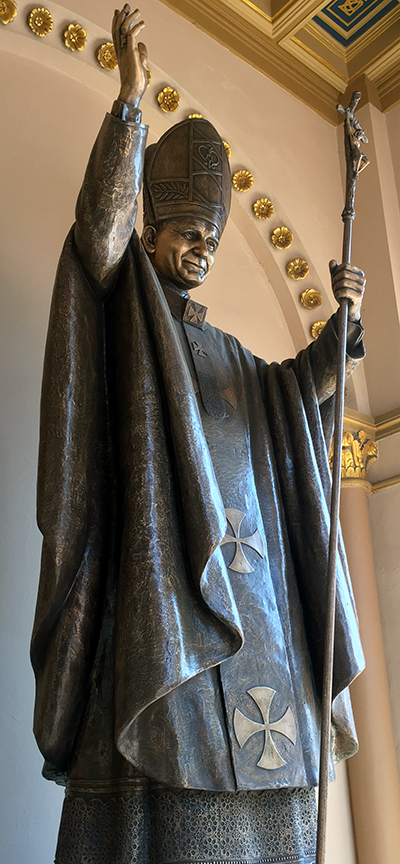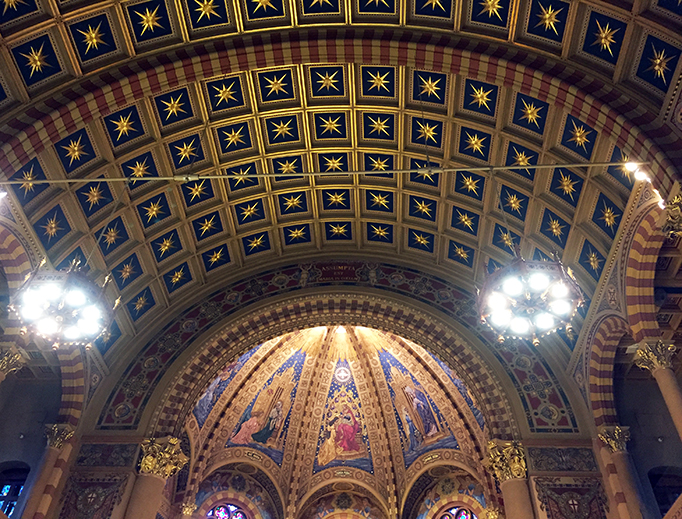Bangkok Cathedral Makes a Proud Man Humble
The architectural message of the church’s beautiful interior is, “I’d seriously reconsider my religion if I were you.”


In the heart of this city ― arguably the most Buddhist city in the world ― lies a remarkable Italianate jewel with just enough French and a couple of well-placed Moorish elements to keep things interesting. Guessing what is what artistically and stylistically in this church’s mesmerizing interior is the ultimate test of cerebral fitness.
It’s as if the very Arm of God reached down to pick up a magnificently-appointed Roman church and gently placed it near a muddy estuary in Southeast Asia. He and the Assumption Cathedral’s architect both did an outstanding job.
Though the name “Bangkok” is synonymous with dubious massage parlors, murky opium dens and Yul Brynner, it’s only a nickname used by people outside of the country. Locals call the city Krung Thep (Thai: The City of Angels) which is itself a shortened version of the official Thai name of Krung Thep Maha Nakhon. However, this name is also an abbreviation of the full ceremonial name ― the longest place name in the world:
Krung Thep Maha Nakorn Arun Rattanakosin Mahinthara Ayutthaya Mahidol Pop Noppharat Ratchathani Burirom Udomratchawiwet Makhasathan Amon Phiman Awatan Sathit Sakkathattiya Witsanukam Prasit
which means:
The Great City of Angels Where the Immortal Divinity Dwells, the Invincible City, the Royal Capital Endowed with Nine Precious Jewels and Full of Joy
Quirky coincidence? Hilarious happenstance? Silly synchronicity? I think not. How apropos that the city’s Catholic cathedral is named after Mary’s Assumption whose Assumption was angelically assisted if one can believe Titian’s and Rubens’ paintings on the subject.
The Assumption Cathedral in the Angelic City. That sounds right.
Following the Siamese government’s abandoning its traditional capital in Ayutthaya and moving the capital to Bangkok in the late 1700s, an unnamed French architect designed the original Assumption Cathedral at the request of missionary Fr. Pascal ― an ethnic Thai-Portuguese whose European ancestors arrived in Thailand in three centuries earlier. The church was built by Bishop Florens of the then-“Siam Missions” in 1820. It was a traditional Thai-style church replete with architectural elements reminiscent of a Buddhist temple.
In 1909, the church underwent a major reconstruction to accommodate the ever-growing Catholic community. Father Colombet, the rector of the cathedral, approached a French architect who designed the master plan. Though most of the building materials used were locally-sourced, the church’s marble is Italian Carrara and the stained-glass windows are French.
The new church was financed by a local Chinese Catholic businessman named Jacobe Low Khiok Chianghe.
The cathedral gathers under its mighty eaves a plethora of architectural styles that, by the sheer audacity of the architect and the awful grace of God, fit coherently, aesthetically and somberly. It’s reminiscent of Renaissance architecture which capitalized on classic Roman elements without eschewing many lovely Gothic elements and was designed to knock the socks off the natives ― that is, if they wore socks, which they do not. This is an unnatural hodge-podge of architectural styles that shouldn’t be — and yet, all of these elements lie side-by-side and contribute to even greater whole, which is greater than the sum of its parts. It’s balanced without being rigid. I'd even go so far as to say it’s whimsical without being a cacophonous Baroque pile. Rather, it’s steady and dignified. Solid and clarifying as if to say the worshiper and tourist alike, “Rest assured, little ones ― Christ loves you.”
The subliminal architectural message of the church’s interior is, of course, “I’d seriously reconsider my religion if I were you.”
The cathedral’s main door is flanked by two enormous bronze statues. St. Peter on the left and Pope St. John Paul II. (The latter visited May 10, 1984. The former is highly active in praying for the local community.)
The cathedral’s altar “faces east.” The outside of the red brick church is unapologetically and symmetrically Romanesque. The twin, square 104 feet (32 meters) towers are unignorable. The roof towers over the heads of worshipers at 83 feet (25.6 meters). Semicircular-arches cap every door and window in the church.
In 1942, during heavy Allied bombardment, several nearby buildings were destroyed resulting in serious damage to the church, which was subsequently restored. Other renovations followed in the 1980s and 1990s.
The Cathedral’s crypt lies underneath the sanctuary and contains the remains of the bishops and the missionaries including that of Blessed Nicholas Boonkerd Kitbamrung ― a Thai martyr beatified by Pope St. John Paul II on March 5, 2000.
Though the greater majority of his relics have been translated to a newly-built shrine at St. Peter’s Church in Sampran, Nakornprathom Province, an altar devoted to the beatus is on the left side of the Cathedral.
As I sat in the pew — which will soon be out of reach for me as a humble but highly-respected foreign journalist when Pope Francis arrives — contemplating the incredible decoration of this almost overwhelming church, I could feel an angel sliding up to me in this City of Angels.
I believe Pope Francis will be impressed not only with the piety of the local Catholics but also with this church.
And yes, it’s definitely “Eurocentric.” Despite people in the West who whine about “colonialism” in the Church, most Asian Catholics have no interest in Catholic saint statues or paintings that depict people who “look like them.” That’s something for “woke” prelates, not for down-to-earth cradle Asian Catholics.
I had a chance to speak with the rector, Fr. Nicholas Preecha, to compliment him on not only the beautiful structure under his care but the remarkable cleanliness of the church. I looked in vain for a single mote of dust, a strand of cobweb or a desiccated leaf but none could be found.
“The Buddhists here really take care of their temples. They are spotless. We do the same for our churches,” he explained. “We have many volunteers in the parish that patrol our church. The Church is our Mother. We must care for her.”


















